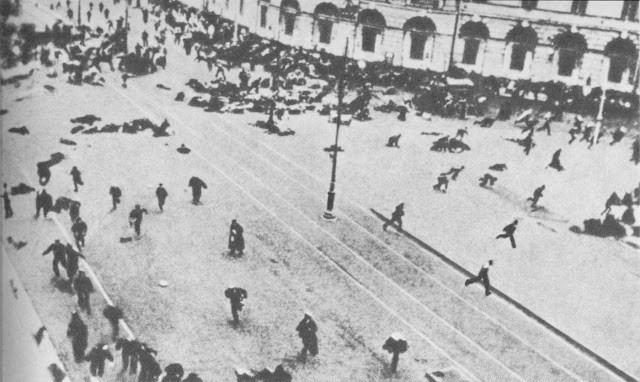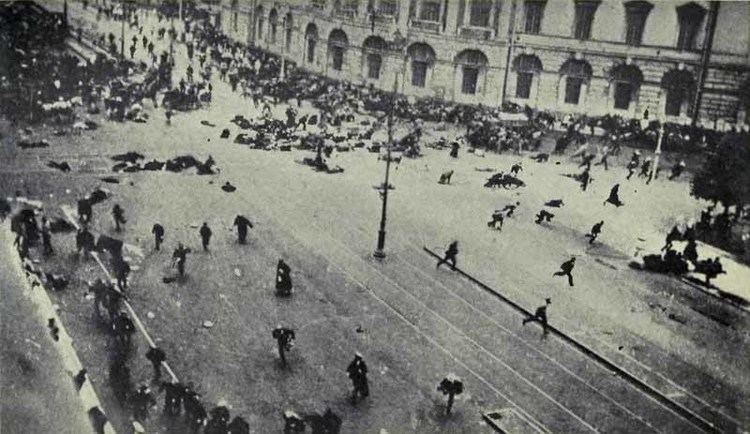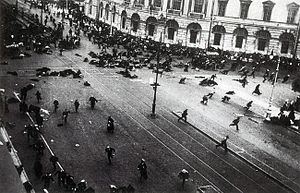700 wounded demonstrators, 16 people killed and 100 arrested 24 killed | Dates 16 Jul 1917 – 20 Jul 1917 | |
 | ||
500,000 unarmed demonstrators, 4,000–5,000 Red Guard soldiers, a few hundred anarchist sailors, and 12,000 soldiers and low-rank officers Several thousand police and soldiers Result Government victory, dispersion of demonstrations and strikes, arrest of Bolsheviks, workers, and sailors. Similar | ||
Russia and the soviet union 3b the july days part 2
The July Days refers to events in 1917 that took place in Petrograd, Russia, between 3 July and 7 July (Julian calendar) (16 July – 20 July, Gregorian calendar), when soldiers and industrial workers engaged in spontaneous armed demonstrations against the Russian Provisional Government. The Bolsheviks initially attempted to prevent the demonstrations and then decided to support them. (Dates given in article Gregorian Calendar.)
Contents
- Russia and the soviet union 3b the july days part 2
- Russia and the soviet union 3a the july days part 1
- Demonstrations
- Bolshevik involvement
- Consequences
- References

The Bolsheviks intended to hold peaceful demonstrations. However, armed clashes broke out. Lenin went into hiding, while other leaders were arrested. The outcome of the July Days represented a temporary decline in the growth of Bolshevik power and influence in the period before the October Revolution.

Russia and the soviet union 3a the july days part 1
Demonstrations

On 16 July spontaneous demonstrations broke out in Petrograd. They were started by the soldiers of the 1st Machine-gun Regiment, who were influenced by the anarchists. At a secret conference on 15 July the anarchists had decided to summon the workers and soldiers of Petrograd to an anti-government demonstration.

The machine gunners' appeal met a favorable response from the soldiers of the Moscow, Pavlovsky, Grenadiers, and 1st Reserve regiments. These units marched out in a demonstration under the slogan "All Power to the Soviets". Workers from factories joined them. The leadership of the All-Russian Central Executive Committee, dominated by Mensheviks and SRs, forbade the demonstration.

The Bolsheviks decided to provide leadership to the movement in order to give it an organized and peaceful character. On the afternoon of 17 July there was a peaceful demonstration by 500,000 workers, soldiers, and sailors under the slogan "All Power to the Soviets". Anti-government demonstrations were also held in Moscow, Nizhny Novgorod, Krasnoyarsk, and other cities.

The military authorities sent troops against the demonstration, leaving more than 700 people killed and wounded. The SRs and Mensheviks supported punitive measures against the insurgents. They began to disarm workers, disband revolutionary military units, and carry out arrests. On 18–19 July the offices and printing plant of Pravda and the headquarters of the Bolshevik Central Committee were destroyed. On 19 July the Provisional Government issued an order for the arrest of Lenin, who was forced to go underground. On 20 July troops loyal to the regime arrived in Petrograd from the front.
Bolshevik involvement
The demands which the workers and soldiers took to the streets with in the July Days were influenced by the Bolsheviks. "All Power to the Soviets" and other slogans put forth by the Bolsheviks were taken up by the workers and soldiers on the streets. The demonstration was organized by the Bolshevik Military Organization (BMO) without initial authorization from the Central Committee after pressure from rank and file soldiers. The Party gave temporary support for the protesters before efforts at the Soviet started to falter. During the afternoon of 16 July, the Central Committee, urged by Kamenev, Trotsky, and Zinoviev, decided to act to restrain the developing situation.
Under the pressure of what seemed like a developing mass demonstration of workers and soldiers in the streets, the Bolshevik leadership (the BMO, the Petersburg Committee, and later on the Central Committee) reversed their decision, coming out in support of the street demonstrations. Both Trotsky and Zinoviev persistently argued for the street protests to remain peaceful. After this decision, the BMO actively organized and supported the demonstration, mobilizing reinforcements from the front lines and dispatching armored cars to capture key posts including bridges and the Peter and Paul Fortress.
No public record was ever made of the internal debates of the Bolshevik Party around the July Days. There were some within the Bolshevik Party who advocated an intensification of activity on 17 July. Most prominent among those were Nikolai Podvoisky and Vladimir Nevsky, leaders of the BMO, V. Volodarsky, a member of the Petersburg Committee, and Martin Latis of the Vyborg District Bolshevik Organization, who was highly critical of the Central Committee's decision to hold back the masses. Others in the Bolshevik Party, including Lenin, were split on what to do. On 18 July at two or three o'clock in the morning, after the Provisional Government dispatched a number of loyal troops from the front to the streets of Petrograd and won the support of a number of previously neutral garrisons of troops, the Bolshevik Central Committee decided to call off the street demonstrations.
Consequences
Kerensky ordered the arrest of Lenin and the other leading Bolsheviks, accusing them of inciting revolt with German financial backing. Lenin successfully went into hiding, staying first in the apartment of Benyamin Kayurov, before fleeing to Finland, but many other Bolshevik leaders were arrested, including Trotsky, Kamenev, and Lunacharsky, who were apprehended on 4 August. They remained in prison until Kerensky released them in response to the Kornilov Affair.
The government crisis was intensified by the resignation of Prime Minister Lvov. On 21 July, Kerensky became prime minister. The SR-Menshevik leadership of the Soviets proclaimed the Provisional Government to have "unlimited powers". The soviets became a powerless appendage of the government. The suppression of the demonstrations marked the end of dual power. The peaceful development of the revolution was seen as impossible.
